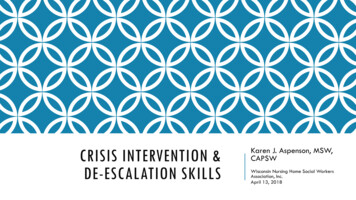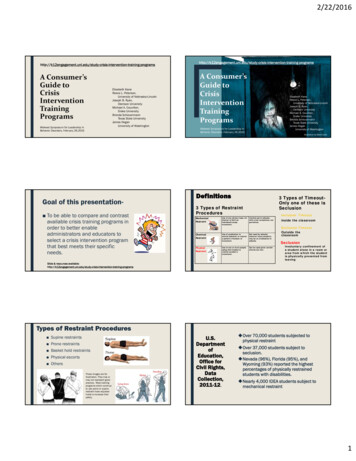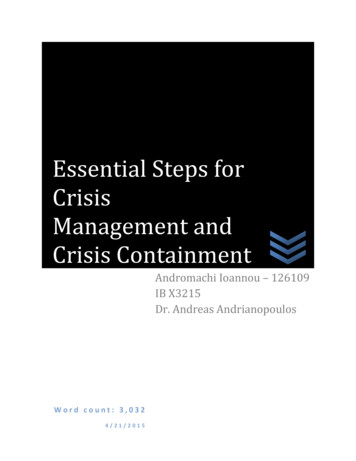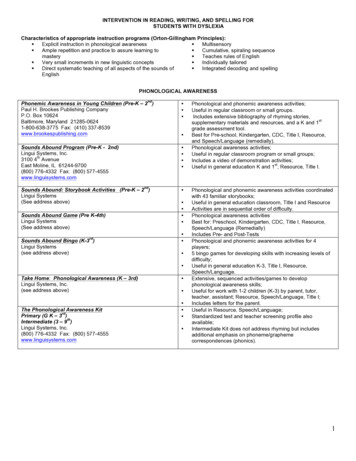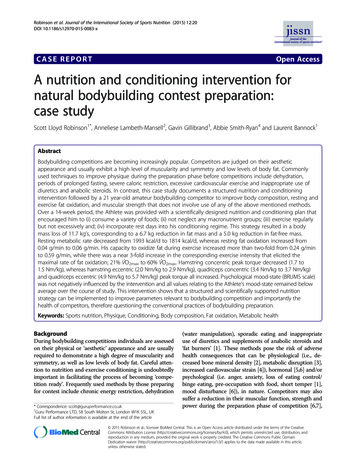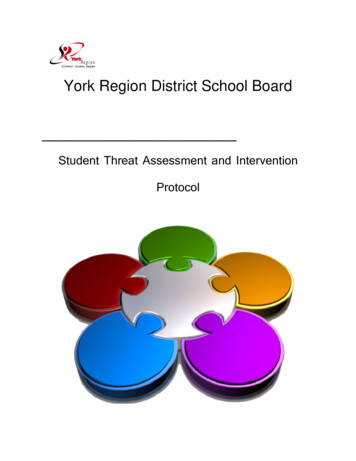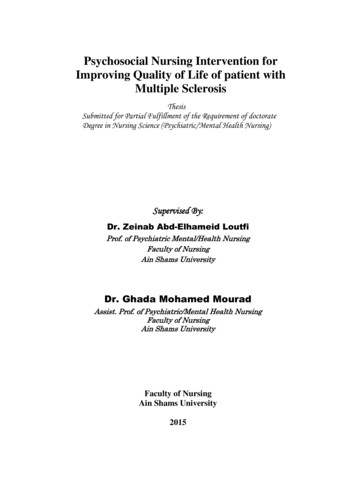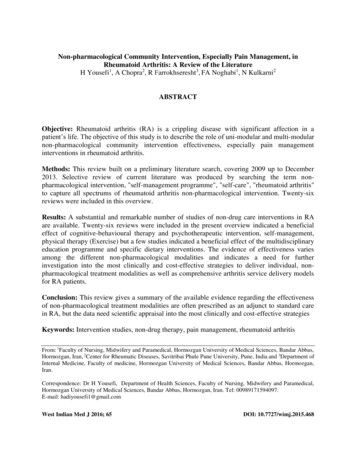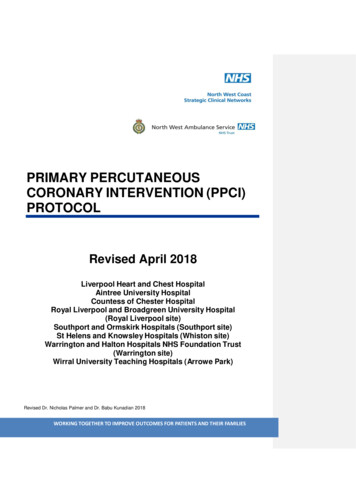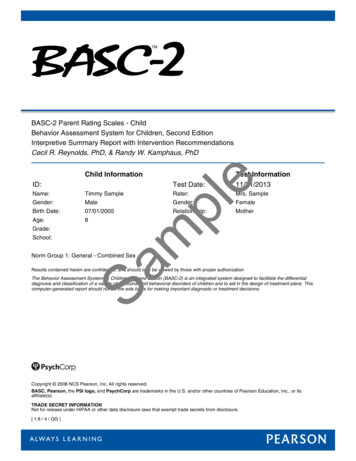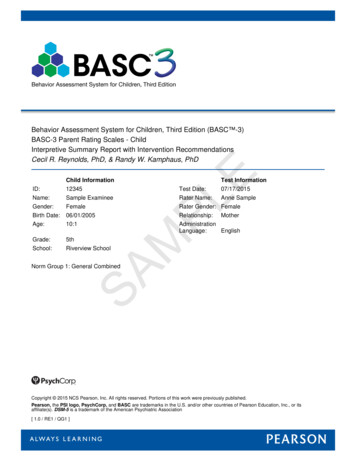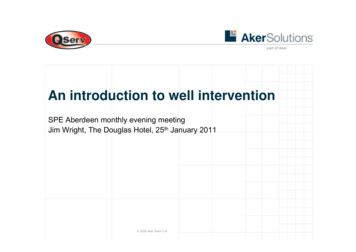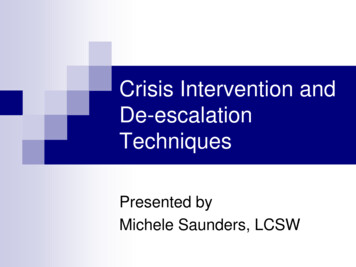
Transcription
Crisis Intervention andDe-escalationTechniquesPresented byMichele Saunders, LCSW
Crisis Intervention Definition of a Crisis Crisisby definition is short-term andoverwhelming and involves a disruption of anindividual's normal and stable state where theusual methods of coping and problem solvingdo not work
Crisis Intervention Crisis intervention is generally characterized by: ahere and now orientation timelimited interactions aview of the individual's behavior as understandable(rather than a pathological) reaction to stress theCIT officer may be expected to analyze thesituation quickly and be very active and directive
Crisis InterventionGuidelines for Crisis Intervention: Immediate intervention will interrupt a prolongedcrisis Action. Be active in helping, exploring andresolving Limited goals. Focus only on goals related toaddressing the crisis Build hope and expectations. Resolution ispossible
Crisis Intervention Foster support because lack of it can lead toincreased negative outcomes Focus on resolution of solving the problem(s)underlying the crisis Build self-image and self-confidence
Crisis InterventionCrisis for People with Mental Illnesses: Most people with serious mental illness have symptomsthat change over time – they get better or worse as aresult of normal life stressors The nature of symptoms can lead to a crisis Many people with serious mental illness have difficultycoping with stressful situations When person stops taking medication and symptomsincrease
The Logic of De-escalation If you take a LESS authoritative, LESScontrolling, LESS confrontational approach, youactually will have MORE control.You are trying to give the consumer a sense thathe or she is in control.Why? Because he or she is in a crisis, which bydefinition means the consumer is feeling out ofcontrol. The consumer’s normal copingmeasures are not working at this time.
Crisis Intervention and De-escalationC.A.F MODEL – Calm, Assess, FacilitateCalm: to decrease the emotional, behavioral, andmental intensity of a situationAssess: to determine the most appropriateresponse as presented by the factsFacilitate: to promote the most appropriateresolution based on an assessment of the factspresented
Benefits of the C.A.F. Model C.A.F is a “fluid process” C.A.F. helps to define the intervention C.A.F. provides a blueprint C.A.Fenhances officer safety
CALM: Response, Communication andDe-escalation Goal: to decrease the emotional, physical andmental stress levels of a situation using verbaland non-verbal de-escalation techniques The officer’s initial response can often facilitatethe direction of the encounter toward a morepractical and appropriate resolution
Guidelines for De-escalationMaintain safe distance (5-6 ft or 21 ft rule) Use clear voice tone Use volume lower than that of theaggressive individual Use relaxed, well-balanced, nonthreatening posture (yet maintainingtactical awareness Set limits
Guidelines for De-escalation (con’t) Be active in helpingBuild hope – resolution is possibleFocus on strengthsPresent self as a calming influenceCIT officer demonstrates confidence andcompassionDo not personalize
Guidelines for De-escalation (con’t) Remove distractions, disruptive or upsettinginfluences Be aware of body language/congruency Be aware that uniform, tools can be intimidating
Guidelines for De-escalation (con’t) Be consistent Use “I” statements Here and now Validation/acceptance No promises you cannot keep
Guidelines for De-escalation (con’t) Recognize that mentally ill person may beoverwhelmed by sensations, thoughts,frightening beliefs, sounds, environment –provide careful explanations, instructions Determine need for food, water and basic needs Use active listening skills
The Negotiator’s Role:Influencing Behavioral ChangeCHANGEINFLUENCERAPPORTEMPATHYACTIVE LISTENINGBehavioralChange StairwayActive Listening is the foundation that supports everything else
Effective Communication 70% of communication misunderstood Effective communication is defined aspassing information between one personand another that is mutually understood
Introduce Yourself An introduction promotes communicationHi, my name is Doug (or Deputy Smith). I am aCIT officer with the Sheriff’s Department.Can you tell me your name?State what you see/know (“I can see you’reupset.”)State or convey that you are there to help.Be prepared to explain the reason you are there(e.g., a neighbor called to say someone is upset)
Active Listening Skills Paraphrasing/Restatement: summarizing whatthe person saidReflectionAttendingOpen-ended questions: requires more detailedanswersMinimal EncouragersEffective PausesSilence: sends the message that your arewilling to listen
RestatementRestating or Feeding Back the facts of theperson’s crisis situationPerson in Crisis:“I stopped taking my medicine after I wasfired and I’m sleeping in my carin my car.”CIT Officer:“You recently stopped taking your medicine,you lost your job, and you don’t have aplace to stay.”
Restatement The FactsConsumer: “I started back using and me and myold lady went to fighting. She left me. I didn’t go intoday. It was my last chance. I’m fired. It’s just notworth it anymore.”CIT Officer: “Let me see if I understand. You’vebeen using again and you and your wife have beenfighting. You lost your job. And you want to giveup.”
Accurate ReflectionReflecting or Feeding Back theperson’s feelings about the crisisPerson in Crisis:“I’m afraid of sleeping in the car. How canI ever get a room without money?CIT Officer:“You’re feeling scared and depressedbecause you don’t have any moneyand no place to stay.”
Reflection The FeelingsConsumer: “I’m a real fuck up. I had two years. Iwas going to meetings. My wife and I were doing okay.Work was good. I can’t do anything right.”CIT: “You sound embarrassed and pretty hopelessabout getting your life back together.”
Empathy: An Essential Concept “Identification/ understanding ofanother’s situation, feelings andmotive.”Understanding is Not Agreement
Empathy: An Essential Concept Empathyis not Sympathy- “.an expression of pity orsorrow for the distress of another.” SympathyAmerican Heritage Dictionary Pity and sorrow are not productiveIt’s not necessary to actually “feel whatthey feel” to provide empathy
RapportRelationship of mutual trust
Communicating AcceptancePePerson in CrisisPerson in Crisis FearfulAnxiousAngry / hostileInsecureParanoidActing strangelySpeaking bizarrelyPoor personal hygieneCIT Officer Respectful Introduction“Please”“Thank you”Smiling whenappropriateConsiders: “What if thisperson in crisis were amember of my family?”
Effective Verbal Intervention Must Be: Specific – precise, explicit, clear Concise – short, to the point, simple Directive – instructive, communicating clearly what youwant the individual to doBroken Record Technique – purposefuluse of repetition
ASSESSMENT: Evaluate the Situation Goal: To determine the most appropriateresponse as presented by the facts Assess for a mental illness and/orsubstance use Assess for Orientation (time, place,person)
ASSESSMENT (con’t)Focus on verbal, behavioral andenvironmental indicators Be aware of signs for suicide and/orviolence Medical emergencies Medical/physical conditions that couldmimic mental illness
Assessing- B.E.F.A.S.T.B – Behaviors E - Emotional/Mood F – False Beliefs and Perceptions A – Appearance S – Speech T – Thinking Form
Assessing – B.E.F.A.S.T. B - Behavior: actions, gait, movement, mannerism E - Emotions/Mood: steady or sustained emotionalstate assess, expressions and feeling tone F - False beliefs & Perceptions: delusions andHallucinations A - Appearance: dress, grooming, posture, gestures,facial expressions S - Speech: rate, volume, and pace, abnormalities T - Thinking form (flow) of thought
Strategies for FrequentlyEncountered Situations
Strategies for Frequently EncounteredSituations Psychotic(Disorganized Thinking)and verbally aggressiveAllow person to vent energy, maintain safedistance, talk in low voice, broken record,reassure
Strategies for Frequently EncounteredSituations HallucinationsValidate the experience for the person, canindicate you don’t hear the voices, haveperson focus on you, offer help, safety
Strategies for Frequently EncounteredSituations Delusionalparanoia)statements (may includeRecognize their view, indicate it is not yourview, but you are willing to help, do notargue or debate, focus person on whatyou need them to do
Strategies for Frequently EncounteredSituations Compulsive Talking (mania)Ask concise, specific, concrete questions;use broken record technique
Strategies for FrequentlyEncountered Situations IntoxicationLet them vent, listen, use a calm, even tone,move person away from others if possible,be reassuring
Strategies for FrequentlyEncountered Situations DepressionActive listening, empathy, take time,reassure, offer hope, validate feelings
Strategies for Frequently EncounteredSituationsSuicidal Person: What position is person putting you in (considersuicide by cop) Present in calm, understanding, non judgmentalmanner Listen Emphasize temporary time-frame of crisis Suggest alternatives Emphasize effect on survivors Lethality assessment (plan, lethal, access, support) Be active in offering hope and help
DONT’SUse Aluminum Foil Listen forever Argue with logic of delusions Agree with delusions/no deception Let your guard down Assume condition will remain constant
DO’sGet comfortable asking questions Try to understand cause of behavior Hand off as necessary Seek consultation Know your limits
FACILITATE: Response ResolutionThe goal is to promote the most appropriatedisposition/resolution to the crisis situationbased on the assessment of the factsgathered, policy and legal obligations of theofficer
Tips for Effective Facilitation Appropriate assessment directsappropriate facilitation Know your community resources Be flexible with alternatives whenappropriate
Courage“Each time someone stands up foran ideal, or acts to improve the lot ofothers, or strikes out againstinjustice, he sends forth a tiny rippleof hope.”Robert F. Kennedy
OFFICER SAFETYIs The PRIORITY
Crisis Intervention Crisis intervention is generally characterized by: a here and now orientation time limited interactions a view of the individual's behavior as understandable (rather than a pathological) reaction t
